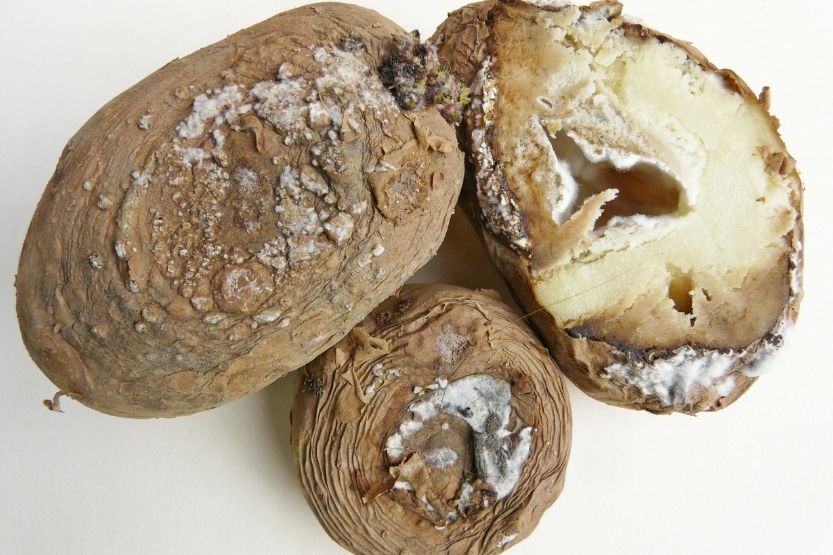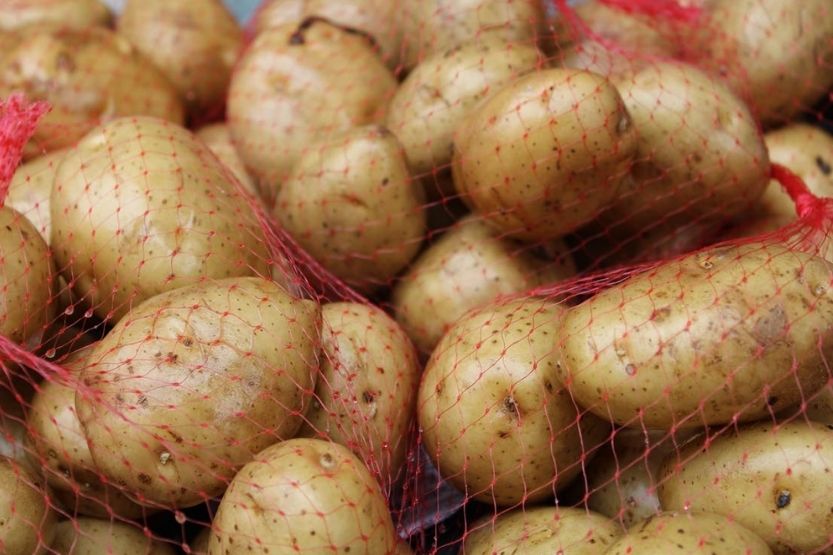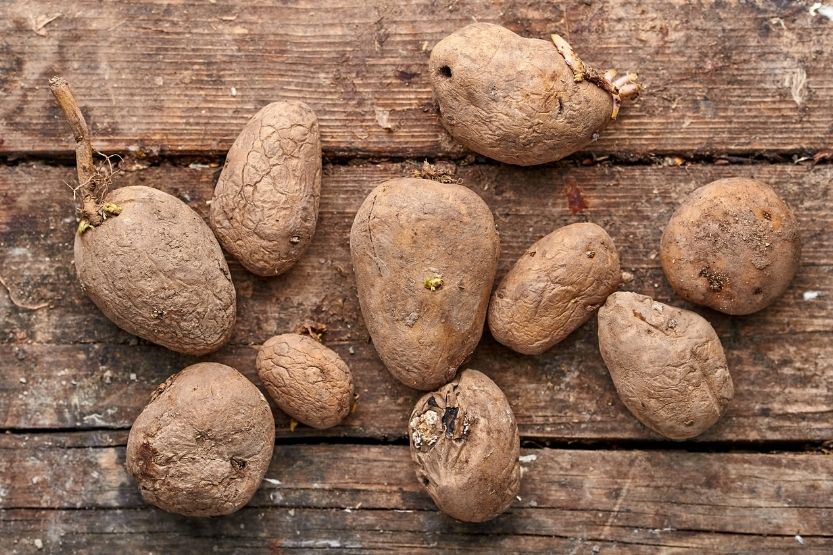You should never eat moldy potatoes because they’re dangerous. They contain solanine, a toxic substance that can cause serious sickness. In this article, I’ll discuss moldy potatoes, how to tell if they are bad, and how to make them last longer.
You can tell a moldy potato by its bruises or dark spots. They will also be mushy and soft to the touch. When sprouts are already growing in them, they are already spoilt. Potatoes that smell moldy or rotten are not to be eaten. You need to discard them.
However, it also depends on the amount of mold or bruise on the potato. Don’t throw away the whole potato if it’s just a small bruise or mold. You can still save a good part of the potato. Just slice or cut the small mold or bruise on the potato and cook or use the rest of it.
Read on to learn more about how to tell moldy potatoes, prevent them from getting moldy, and what you can do to them.
About Moldy Potatoes

Moldy Potatoes Have Dark Spots or Bruises
A moldy potato will have dark spots or bruises. They’ll also feel soft and mushy to the touch. If you see sprouts in them, they are already spoilt. When they smell rotten or moldy, you should not use or cook them but discard them altogether.
Cut Off the Small Mold to Salvage the Potato
However, if it has only a tiny mold or bruise, you can still salvage the potato. Also, you can still save it if it is not affected by the mold. Just slice or cut off the small mold and use the remaining part.
You can still cook and eat the rest of the potato once you have removed the moldy spot. Just be sure that you cut an inch or so around the moldy spot to be safe.
White Potato Mold Due to Sclerotinia sclerotiorum
A raw potato can grow white potato mold because of Sclerotinia sclerotiorum. It produces fluffy white mycelium and black, hard, and irregularly shaped sclerotia. This type of mold has a wide host range.
How to Tell If a Potato Is Moldy?
If you store potatoes properly, they can stay fresh for several months. They’ll be firm to the touch and smell good. Does one moldy potato ruin the others? Bad potatoes can be a menace if they are bunched together with the good ones. Several signs will show you if a potato is bad or not.
The most common signs are bruises or dark spots on the potato. If the potato has already grown mushy or soft, the whole potato has gone bad totally. Another sign of spoilage is the presence of sprouts on the potato. If it smells moldy or even rotten, then it is undoubtedly spoilt.
How can you tell a moldy potato? Here are some of the most commons signs:
1. Moldy Spots and Smell
Mold has a distinct smell and appearance. Good potatoes emit an earthly scent that you can easily recognize. The smell is fresh and healthy. However, once the potato emits a musty smell like mildew, it is no longer safe to eat or use.
A potato going bad will also develop mold spots. It can only be a small patch that can grow larger if not sliced or cut off from the potato. You need to cut off this small moldy spot right away to save the rest of the potato. The vegetable can be salvaged at this stage.
2. Soft and Wrinkly Appearance
Another easy way to tell a moldy potato is if it is soft to the touch and its skin appears to be wrinkled. As a potato gets older, its skin wrinkles and its flesh becomes soft. So, if you see a potato that has wrinkled and saggy skin, you should not use or cook it any longer.
Wrinkled skin in potatoes is almost always accompanied by mushiness of the flesh. When a potato is nearing the end of its life, it will acquire certain softness compared to its original solid state. It means the vegetable is already spoilt. Its moldy potato toxicity is very high.
3. Presence of Sprouts
If little shoots are sprouting on the potato, that’s a sure sign that it is no longer good to eat. These small shoots are high in solanine, a toxic substance. They are a sign that shows that a potato is starting to expire.
But that doesn’t mean that the whole potato has gone bad. If you still want to use the potato, and it is not yet mushy, you need to excise the sections with the small shoots and cook the rest of the potato as soon as possible.
4. Potato Turning Green
If the potato starts to change its color, it is slowly deteriorating. Most often, rotten potatoes turn green because of the growth of solanine. This usually happens when the potato is overexposed to sunlight.
This situation accelerates the normal development process of green spots on potatoes, so you should not eat these greenish potatoes because they are high in solanine.
As a result, it may cause gastrointestinal conditions, including:
- Stomach cramps,
- Dizziness,
- Nausea, and
- Paralysis.
You can no longer salvage any part of a potato that has already turned greenish.
5. Moisture Leaks in Sweet Potato
White potatoes are the most common in the west. Meanwhile, sweet potato is another kind of potato popular in other parts of the world. And they can also go bad.
A sign that a sweet potato is expiring is the presence of black or brown spots. The moldy sweet potato toxicity is high when brown spots are already present.
Moisture leaking from the sweet potato is another sign of a moldy sweet potato. These potato types have high amounts of water compared to white potatoes.
Again, can you still eat a moldy potato? Moldy potatoes are safe to eat as long you remove the moldy spot. The same is true with turnips and bell peppers.
How to Prevent Moldy Potatoes

Potatoes don’t spoil that fast. However, how long they last will depend on your storage quality and the weather conditions in your area. These vegetables can stay viable if stored at the ideal temperature and condition.
That’s why potatoes getting moldy is not very common. Raw potatoes are usually hardy and can last for weeks in many households. You can make them last longer if you follow this guide:
1. Buy Good Potatoes
Buy potatoes with smooth skins, no bruises, cuts, wrinkles, or blemishes.
2. Store Potatoes in a Cool, Not Cold Space
Once you bring them home, store the potatoes in a cool, dry place. Your pantry is the best place. You can also store them in your cellar if there are no spaces available in your pantry. Store the potatoes at a temperature ranging from 45°F to 55°F.
If you can’t provide this kind of storage place for your potatoes, you can store them in your fridge. However, you can’t fry potatoes stored in the fridge. You can, but they won’t taste as good as the ones stored out of the fridge.
3. Keep Potatoes Away from the Sun
You should also keep your potatoes away from sunlight. Exposure to sunlight will make it turn green fast. So, the best place to store them is in a dark place like your cellar or pantry.
4. Store Them Where There Is Good Airflow
Good air circulation in the storage place is important if you want your potatoes to stay fresh for weeks. With good airflow in the storage, moisture will not be able to accumulate. The presence of moisture in a storage place can accelerate the spoilage of vegetables.
Suppose there is no adequate air circulation in the storage place. In that case, the moisture contained inside the potatoes will accumulate inside the storage place or container and cause the growth of bacteria and mold.
You can store your potatoes in containers, bowls, or paper bags with holes. If they come in plastic bags, transfer them to a basket or a container with holes so they can breathe.
In this way, air will be able to circulate freely. This will prevent the accumulation of moisture inside the container. You can prevent moldy potatoes in the bag if you do this.
5. Don’t Store Them with Onions and Other Vegetables
Don’t store potatoes with other vegetables, especially onions. Onions produce gases that will accelerate the spoilage of potatoes. Many vegetables and fruits also emit ethylene gas as they start to ripen. This helps them to soften and increase their sugar content.
However, if they are stored near potatoes, the fruits and vegetables’ gases will also make your potatoes soft. So, don’t store your potatoes together with tomatoes, bananas, onions, apples, etc. In addition, the ethylene gas that they produce will also cause the potatoes to generate sprouts.
6. Don’t Wash Potatoes Before Storing
You can’t help potatoes from having dirt on their skins. That’s how they grow beneath the ground. It is very tempting to wash them first before storing them since we humans, most of us at least, like to be clean.
But potatoes don’t mind being dirty. Washing to clean them will get them wet. And fresh potatoes don’t like to get wet. They will stay fresh longer if you keep them dry. Washing them will add moisture to their skins, promoting the growth of fungus and bacteria.
So, don’t wash them until you are ready to use or cook them. Just use a soft brush to remove any stubborn dirt on their skins. You need to get them dry as much as possible when in storage so they won’t get moldy.
7. Don’t Store Potatoes Inside the Freezer or the Fridge
Cool storage places are cool for raw potatoes. But the fridge or the freezer is not. What happens if you eat a moldy potato from the freezer?
When you store potatoes at very low temperatures, this will result in ‘cold-induced sweetening.’ This happens when the potato’s starch contents are transformed into sugar.
Potatoes contain acrylamides, a carcinogenic substance. And storing potatoes in the fridge will result in an increased concentration of acrylamides.
A freezing temperature can also cause the potato to turn brown. When it’s time to cook the frozen potato, it will turn mushy and brown.
You can freeze potato once it has already undergone some form of cooking. The heat from the cooking process deactivates the browning enzymes of the potatoes and prevents them from getting discolored.
What You Can Do To Stretch the Life of Your Potatoes
Would it be good if you could store your potatoes longer than normal? Thankfully, there is a process that can do exactly that. Canning the potatoes will make them last longer.
By doing this, your potatoes will be able to last for as long as five years. You will need a pressure canner to do this, plus several glass jars where you can store the potatoes properly. There are several recipes that you can use in canning your potatoes. Many of these recipes are available online.
Frequently Asked Questions

Moldy potatoes have raised many questions about their causes and if you can still use them. To help you get better informed about this topic, here are some of the answers to the most often asked questions about moldy potatoes:
How Can You Tell If a Potato Is Moldy?
If the potato has bruises or dark spots, it is considered a moldy potato. A rotten potato also feels soft and mushy to the touch.
The growth of tiny sprouts on the potato is another sign that it is already going bad. If you see any of these signs on your potatoes, discard them. Don’t use, cook, or even eat them.
What Can I Do with a Potato That Has Mold?
If the potato is overgrown with molds, you need to throw it away. It is hazardous to use or cook a potato when it has reached this stage. The potato has already accumulated a lot of toxins that will make you sick if you eat it.
However, you can still save the potato if the mold growth starts in a small spot. Just slice off or cut off the part where the mold starts to grow to save the rest of the potato. Be sure to cut about an inch around the mold spot to be safe.
Do I Need to Throw All the Potatoes If One of Them Is Moldy?
No, it’s not necessary to do that. However, you have to throw the moldy potato right away, or it will contaminate the whole bunch of potatoes. You can isolate and discard the potatoes near the moldy potato.
How Can I Prevent My Potatoes from Getting Mold?
There are many ways you can prevent your potatoes from being attacked by fungus and molds.
- Only buy potatoes with no bruises, cuts, or skin blemishes.
- Store them in a cool, dry place with enough air circulation.
- Don’t wash potatoes until you are ready to cook them.
- Don’t store them in your freezer and not even in your fridge.
- If they come in retail plastic bags from the supermarket, readily transfer them to an open container or a paper bag with holes so air can freely circulate them.
- Don’t store them near other vegetables, especially onions.
What Causes the Mold on My Potatoes?
The white mold in your potatoes is generated by a fungus called Sclerotinia sclerotiorum. This fungus creates fluffy and white mycelium. It also creates black, solid, and irregularly shaped scletoria.
How Long Can Potatoes Last in the Freezer?
If you want to store your potatoes in the freezer, you need to blanch them first. It’s not advisable to store raw potatoes in the freezer because they will turn mushy and brown when you need to cook them.
Cut your potatoes into small pieces before blanching them. Blanching takes several minutes of boiling before tossing the potatoes into ice water.
Then put them into airtight containers before placing them in the freezer. This will allow you to stretch the life of your potatoes for a maximum of 10 months.
In Closing: Moldy Potatoes
You can know a moldy potato if it has bruises or dark spots. If it feels mushy and soft to the touch, you need to discard it. When you see sprouts growing in them, it is a sign that they are already spoilt. If they smell rotten or moldy, you have to throw them away.
But if the mold or bruise on the potato is only small, don’t throw the whole potato away. You can salvage the larger viable part of the vegetable. Just slice off or cut the small mold or bruise and use or cook the rest of the potato.
Read next:
How Long Does Pork Last in the Fridge – Raw and Cooked
How Long Does Meat Last in the Fridge? Raw and Cooked



